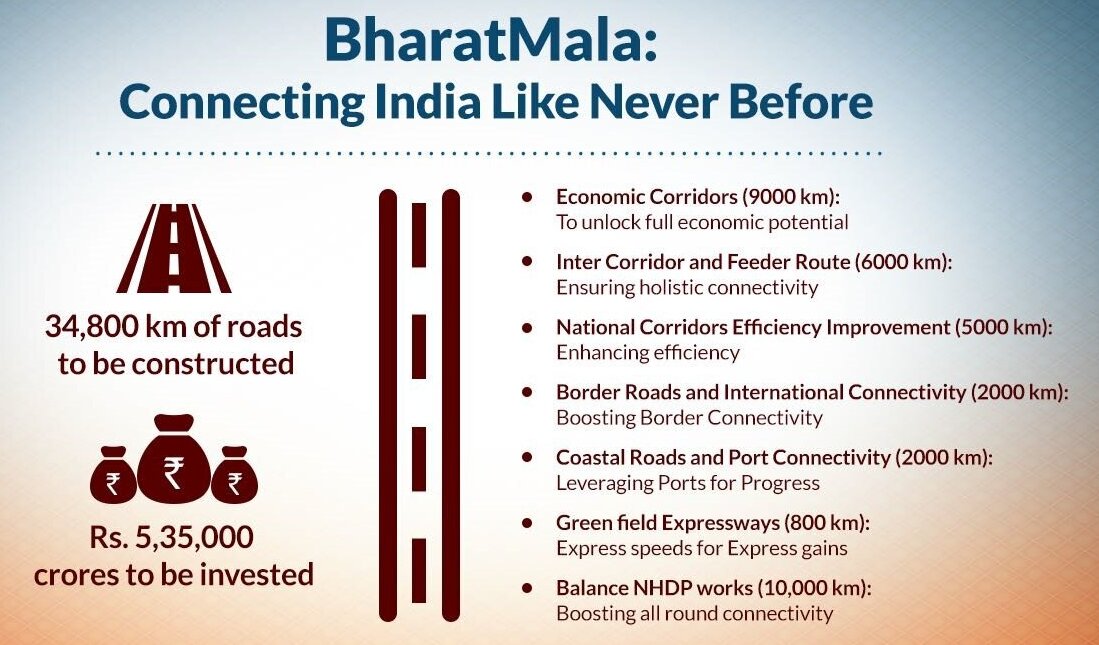Governance
Status of Bharatmala Pariyojana
- 12 Oct 2020
- 4 min read
Why in News
A total of 322 projects in a length of 12,413 km have been awarded and 2921 km has been constructed under Bharatmala Pariyojana till August 2020.
Key Points
- Bharatmala Pariyojana is an umbrella program for the highways sector envisaged by the Ministry of Road Transport and Highways.
- Under Phase-I of Bharatmala Pariyojana, implementation of 34,800 km of national highways in 5 years (from 2017 to 2022) has been approved at an estimated outlay of Rs. 5,35,000 crore.
- National Highways Authority of India (NHAI) has mandated the development of about 27,500 km of national highways under Phase-I.
- However, as per ICRA Limited, Phase-I is likely to be delayed by four years due to the prevailing uncertainty due to Covid-19 and consequent impact on valuations.
- ICRA Limited is an Indian independent and professional investment information and credit rating agency.
- Phase-II envisages around 48,000 km of road network across India by 2024.
- Objectives:
- To optimise the efficiency of freight and passenger movement across the country by bridging critical infrastructure gaps through effective interventions.
- The effective interventions include the development of economic corridors, inter corridors and feeder routes, national corridor efficiency improvement, border and international connectivity roads, coastal and port connectivity roads and greenfield expressways.
- Economic Corridors: These are integrated networks of infrastructure within a geographical area designed to stimulate economic development.
- Greenfield Projects: They lack constraints imposed by prior work on the site. Typically, it entails development on a completely vacant site and architects start completely from scratch.
- Brownfield Projects: They carry constraints related to the current state of the site and might be contaminated or have existing structures that architects have to tear down or modify in some way before the project can move forward.
- The effective interventions include the development of economic corridors, inter corridors and feeder routes, national corridor efficiency improvement, border and international connectivity roads, coastal and port connectivity roads and greenfield expressways.
- To generate a large number of direct and indirect employment opportunities in the construction and infrastructure sector and also as part of the enhanced economic activity resulting from better road connectivity across the country.
- To connect 550 districts in the country through national highway linkages.
- To optimise the efficiency of freight and passenger movement across the country by bridging critical infrastructure gaps through effective interventions.
- Features:
- Improvement in the efficiency of existing corridors through the development of Multimodal Logistics Parks and elimination of chokepoint.
- Multimodal Logistics Parks are a key policy initiative of the Government of India to improve the country's logistics sector by lowering overall freight costs, reducing vehicular pollution and congestion, and cutting warehousing costs.
- A chokepoint is a single point through which all incoming and outgoing network traffic is funnelled and hence, leads to congestion and traffic.
- Enhance focus on improving connectivity in North East and leveraging synergies with Inland Waterways.
- Emphasis on the use of scientific and technological planning for Project Preparation and Asset Monitoring.
- Satellite mapping of corridors to identify up-gradation requirements.
- Delegation of powers to expedite project delivery for successful completion of Phase I by 2022.
- Improvement in the efficiency of existing corridors through the development of Multimodal Logistics Parks and elimination of chokepoint.
- Project Categories:





